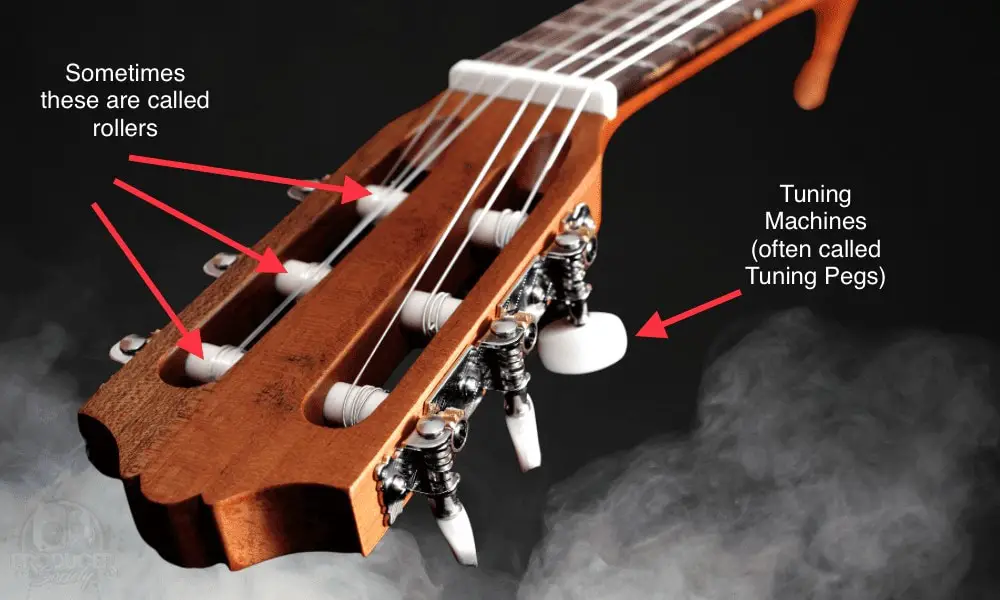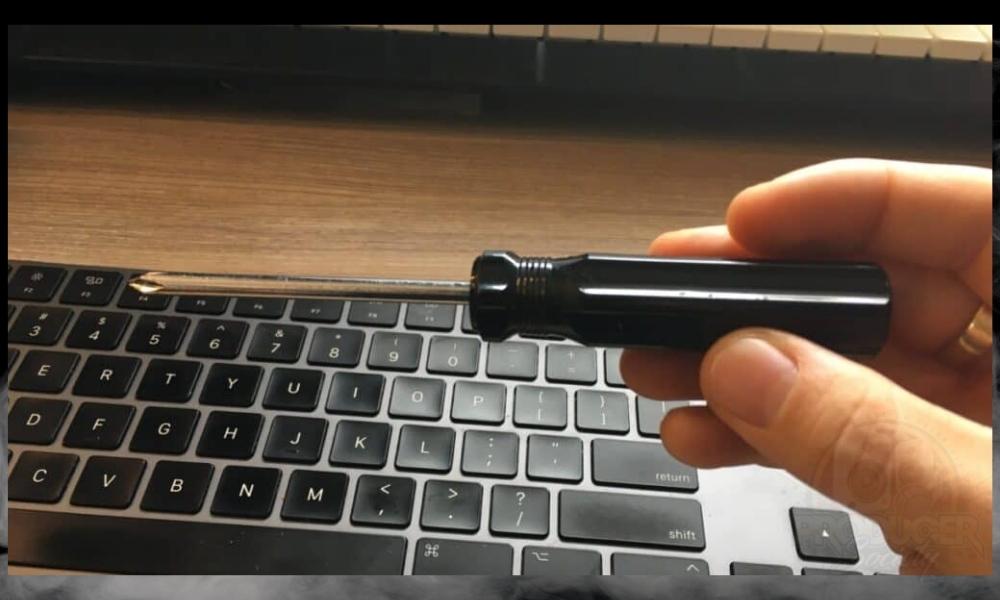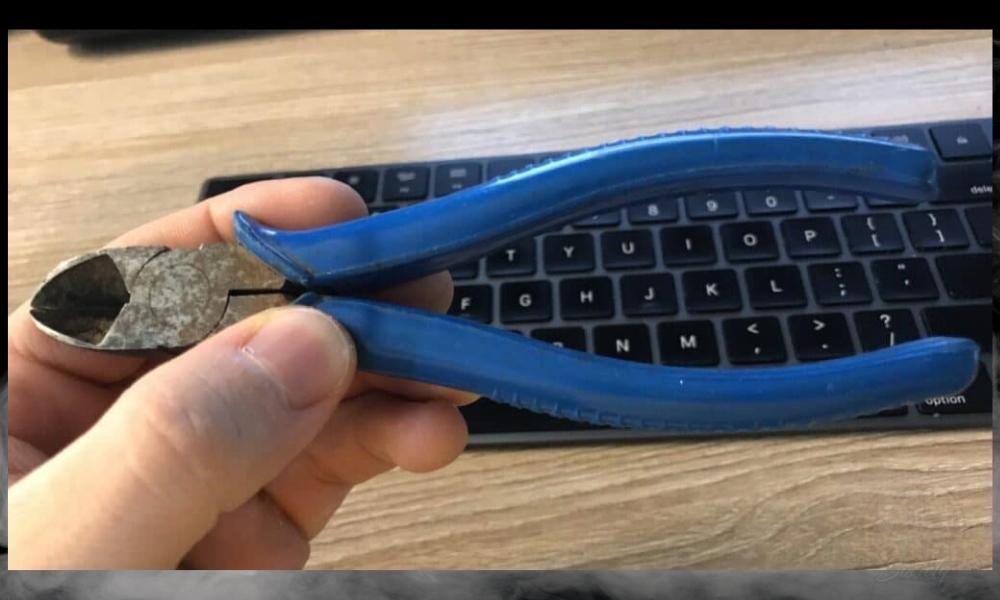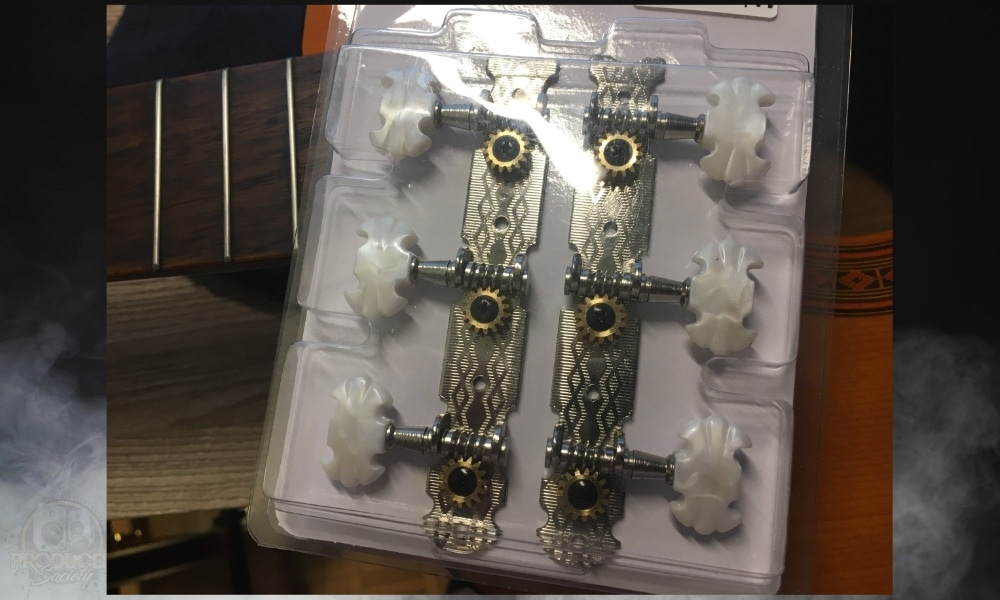To replace tuning pegs on a classical guitar, cut your strings with wire-cutters to remove and then unwind them from the rollers and the bridge. Take out the screws on the tuners with your 1/4” screwdriver to pull them off the guitar. Put on your new tuning pegs and screw them in.
Changing the tuners (also called rollers) on your classical guitar is actually pretty easy if you have the right tools, including a screwdriver, some wire-cutters, and the right size of tuning machines/rollers. The last part is especially important and we’ll discuss it later.
I bought a nylon string guitar from a friend in University around 7 years ago and it has served me well, considering it only cost $50. That said, it has needed a set of new tuners for ages and I never got around to fixing it until recently. I never even changed the strings.
When I finally decided to fix it, I decided it would be wise to make an article and tutorial on it which is what I’ve done here today. If you’ve got new tuning machines and a standard screwdriver, you won’t find it hard. Anyway, let’s get into it in more detail down below.
How to Replace A Classical Guitar’s Tuning Pegs

Assuming you’ve got a solid classical guitar that isn’t total garbage, you shouldn’t find it hard to get your hands on the right tuning machines.
There are standard tuning peg sizes that are seen across many different models, but that doesn’t mean you shouldn’t be careful when buying new ones because you could get burned.
Do yourself a favor and measure the distance between the screw holes on your nylon string guitar as well as the actual rollers themselves (the white pegs that are inserted into the wood of the guitar headstock).
Anyway, let’s talk about some of the other gear you need to make all of this possible. Thankfully, you don’t need a whole lot. If you’ve done any DIY guitar stuff before you’ve probably already got all of these tools.
What You Need to Replace Your Classical Guitar Tuning Pegs
1) A 1/4″ Phillips Screwdriver

You can usually find these screwdrivers on Amazon, but I haven’t had the best of luck there lately. It seems a lot of reputable companies, particularly home hardware brands, have removed their stuff from there.
Check my product page out to see if you can find one. If not, your local department store should have some screwdrivers – it’s not like they’re that difficult to find.
2) Wirecutters

Having a solid set of wirecutters is convenient as a guitarist because it makes changing strings – mostly taking them all off at once – a lot easier.
It’s not uncommon for vice grips to have a wirecutter right on them but actual wirecutters are much better. You’ll need these because if you want to replace your rollers and tuning machines on your classical guitar, you’ll need to take every single string off.
3) New Tuning Pegs (and Rollers)

You can find tuners/rollers just like these on Amazon. From what I’ve personally seen, the tuning machines almost always come attached to the rollers but there could be models where this isn’t the case.
3 Tips for Getting New Tuners/Rollers
1) Make Sure To Measure Your Tuners/Rollers
If I were you, the first thing you should do is take off your tuners and measure the distance between the rollers with a measuring tape or a ruler. You could even have them on hand with you when you go to the store to buy new ones.
As I said earlier, there aren’t a ton of different options when it comes to tuning machines and rollers for nylon string guitars (at least from what I’ve seen), but you can make a mistake when buying them.
This is what happened to me. My classical guitar is junk and none of the standard rollers worked on it so I had to bore the holes out a little bit more on the tuners in order to make them fit. It all worked out in the end though.
2) Additionally, Measure The Distance Between Screw Holes
Another thing you’ll want to do is measure the distance between the screw holes. This is actually where the issue was with my guitar.
The rollers and tuning machines fit perfectly on my guitar, it was the screw holes that caused the issue. A cordless drill and drill-bit is all it took to fix the holes though because they were off by just a little a bit.
3) Some Rollers Are Longer Than Others (Short vs Long)
Another thing that’s important to note is that on some tuners, the attached rollers are actually a bit longer or shorter than others. In my case, the short tuners worked just fine. This is another reason why you’ll want to take your tuners off initially.
Take a few measurements including the distance between the screw holes, the distance between the rollers, and the length of those rollers, before you head out and buy new tuning machines.
One good thing you could do is buy several sizes of tuning machines/rollers from Amazon and then ship back whichever one doesn’t match the size of the ones you pulled off your guitar. But I digress. Let’s get into the actual tutorial now.
1) Put Your Guitar On Your Work Bench Or Table
![[1] Guitar On Work Bench - How to Change Tuners on A Nylon String Guitar](https://travelingguitarist.com/wp-content/uploads/2023/02/1-Guitar-On-Work-Bench-How-to-Change-Tuners-on-A-Nylon-String-Guitar-1000-×-600-px.jpg)
I also have a stand-up desk which has proven immeasurably useful over the last few years. It’s great because if I need to do some luthier-style work, I can just bring the desk up remotely.
I couldn’t recommend a desk like this one enough. You can find one very similar to mine on Amazon. It’s dope.
2) Cut The Strings Off With Your Wire Cutters
![[2] Cut Strings Off - How to Change Tuners on A Nylon String Guitar](https://travelingguitarist.com/wp-content/uploads/2023/02/2-Cut-Strings-Off-How-to-Change-Tuners-on-A-Nylon-String-Guitar-.jpg)
Some people say it’s not good for the guitar to cut the strings near the sound hole (or where the pickups would be on the electric guitar), but I’ve seen guitar technicians do just this.
I think guitarists are too sensitive and anxious sometimes about their gear. What I will do though is loosen the strings just a bit so there isn’t so much of a “snap” when I cut them. I’d rather relieve the tension gradually rather than all at once suddenly.
![[2.5] Cut Strings Off - How to Change Tuners on A Nylon String Guitar](https://travelingguitarist.com/wp-content/uploads/2023/02/2.5-Cut-Strings-Off-How-to-Change-Tuners-on-A-Nylon-String-Guitar-.jpg)
Now you have to pull all of your nylon strings out of your bridge and your headstock which can take a minute. I usually start with the bridge for no particular reason.
3) Unwind The Strings From The Bridge
![[3] Unwind Bridge Strings - How to Change Tuners on A Nylon String Guitar](https://travelingguitarist.com/wp-content/uploads/2023/02/3-Unwind-Bridge-Strings-How-to-Change-Tuners-on-A-Nylon-String-Guitar-.jpg)
Changing nylon strings isn’t something I’ve done a lot of, I must admit, but what I can say is that unwrapping them from the bridge is pretty easy. At least if it has been done correctly.
If you really have to, take your wire-cutters and just find a loose spot and cut it there. Once you’ve done that, you’ll have to unwrap them from the rollers on the headstock as well.
4) Unwind The Strings From The Headstock
![[4] Unwind Headstock Strings - How to Change Tuners on A Nylon String Guitar](https://travelingguitarist.com/wp-content/uploads/2023/02/4-Unwind-Headstock-Strings-How-to-Change-Tuners-on-A-Nylon-String-Guitar-.jpg)
After you’re done taking your strings off, you might as well clean your guitar thoroughly because it has probably been a while since you’ve done so.
5) Clean Your Guitar While You’re At It
![[5] Clean Guitar - How to Change Tuners on A Nylon String Guitar](https://travelingguitarist.com/wp-content/uploads/2023/02/5-Clean-Guitar-How-to-Change-Tuners-on-A-Nylon-String-Guitar-.jpg)
Give it a good rub-down all over the body, neck, and the back of the guitar too.
![[5.5] Clean Guitar - How to Change Tuners on A Nylon String Guitar](https://travelingguitarist.com/wp-content/uploads/2023/02/5.5-Clean-Guitar-How-to-Change-Tuners-on-A-Nylon-String-Guitar-1000-×-600-px.jpg)
This is actually the first time I’ve ever cleaned this guitar and it really shows from the towel.
As a matter of fact, the neck was so dirty that I had to pull out the 0000 steel wool to clean it. After I was done with it, I sprayed it a few more times and went at it again with the towel.
Once you’ve cleaned your guitar and you’re ready to put new pegs on it, grab your screwdriver and then you can take your screws out. This will take just a second.
6) Unscrew The Outside Screws From The Tuning Pegs
![[6] Unscrew Outside Screws - How to Change Tuners on A Nylon String Guitar](https://travelingguitarist.com/wp-content/uploads/2023/02/6-Unscrew-Outside-Screws-How-to-Change-Tuners-on-A-Nylon-String-Guitar-.jpg)
There’s actually a screw in the center of the gear. Don’t try loosening it because it’s a part of the mechanism that shouldn’t be messed with. You want to loosen the screws of the plate, on the outside of the gear, not the gears itself.
7) Pull The Rollers Right Out
![[7] Pull Rollers Out - How to Change Tuners on A Nylon String Guitar](https://travelingguitarist.com/wp-content/uploads/2023/02/7-Pull-Rollers-Out-How-to-Change-Tuners-on-A-Nylon-String-Guitar-.jpg)
Do this on both sides and then you’re good to put new pegs and rollers on your nylon string guitar.
8) Slide Your New Rollers In
![[8] Slide New Rollers In - How to Change Tuners on A Nylon String Guitar](https://travelingguitarist.com/wp-content/uploads/2023/02/8-Slide-New-Rollers-In-How-to-Change-Tuners-on-A-Nylon-String-Guitar-.jpg)
If you’re wondering if there is a left and right in terms of your tuning pegs: the answer is “yes.”
You’ll find one side of the tuning peg set will go on the one side and the other will go on the other side. You’ll figure this out through trial and error.
9) Screw In The New Tuners/Rollers
![[9] Screw New Rollers In - How to Change Tuners on A Nylon String Guitar](https://travelingguitarist.com/wp-content/uploads/2023/02/9-Screw-New-Rollers-In-How-to-Change-Tuners-on-A-Nylon-String-Guitar-.jpg)
From here, turn the tuning machines so the holes of the rollers face upward. This will make tying new strings around them much easier.
But this is a topic for another day. Putting new strings on is a whole other tutorial with a lot more steps and information.
I haven’t made a guide yet on how to change strings on a classical guitar, but I will in the coming months. So stay tuned.
Other Articles You May Be Interested In
- Are Nylon Guitar Strings Easier To Play?
- How Many Guitars Do You Need?
- Are Electric Guitar Strings Different Than Acoustic?
- How Often Should You Get A New Guitar [ANSWERED]
Important Things To Note About Replacing Tuners/Rollers
1) You Can Use A Grinder Or Cordless Drill To Bore Out New Holes If You Need To (On the Tuners – Not Your Guitar)
If you did what I did and you grabbed tuning pegs that, unfortunately, didn’t have matching screw holes, don’t fret.
If you have a cordless drill, you could always bore a slightly bigger hole out on the tuning machines. I would recommend doing it this way, because you don’t want to drill new holes in your guitar.


 Written By :
Written By :
